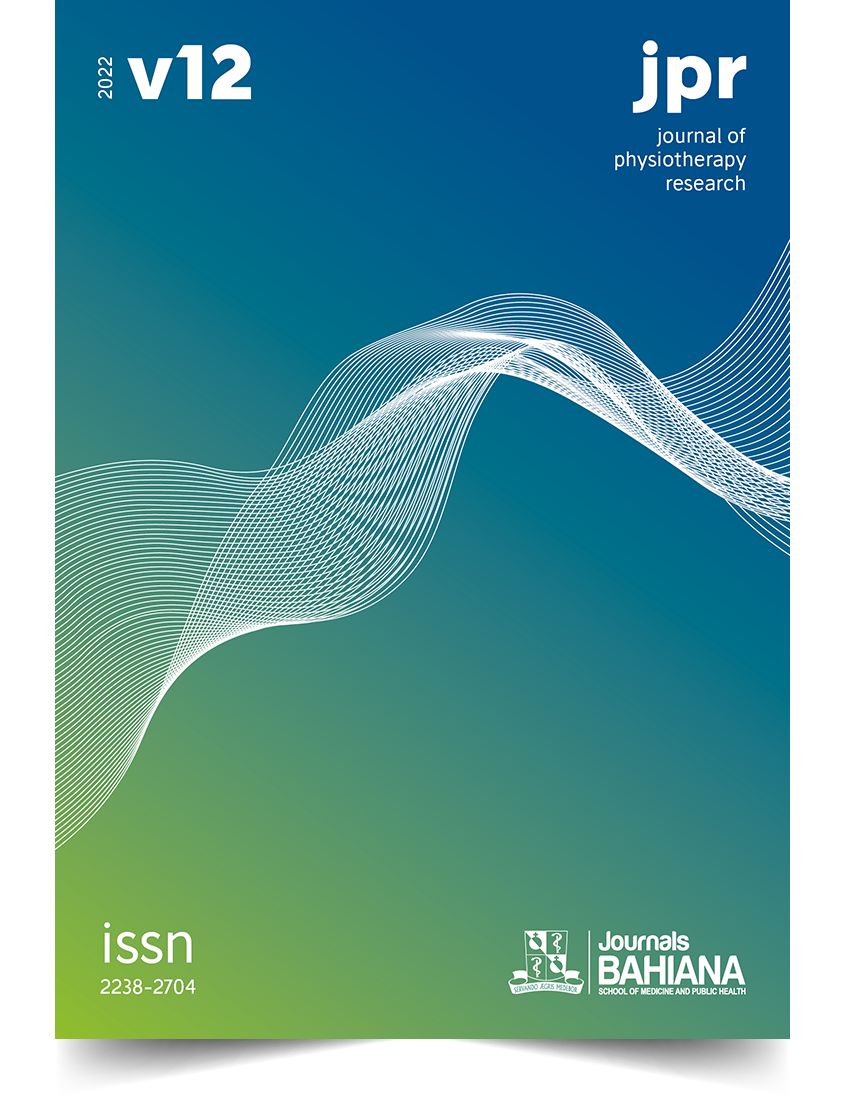Thirty second sit-to-stand test performance in community dwelling geriatric population: a cross-sectional study
DOI:
https://doi.org/10.17267/2238-2704rpf.2022.e4600Keywords:
Body mass index, Geriatric, Sit-to-stand testAbstract
OBJECTIVE: To find the reference values for the 30-second sit-to-stand test and study the correlation of anthropometric measures with the test in the community-dwelling geriatric Indian population. MATERIAL AND METHODS: 136 individuals aged >60 years were recruited in this cross-sectional observational study. The study was conducted in India. After the initial screening, anthropometric measurements were recorded. Then, the 30-second sit-to-stand test was conducted. RESULTS: Normal decade-wise values for the test were reported to be (mean ± SD): 60-70 years (10.2±3.6), 71-80 years (9.5±3.4), and 81-90 years (8.5±5.2). Age, height, waist circumference, and hip circumference were significantly associated with the 30-second sit-to-stand test values. CONCLUSION: Normal values for the test in the community-dwelling geriatric population were reported to be mean ± SD 10.0±3.7. Anthropometric factors should be taken into consideration when performing the 30-second sit-to-stand test in clinical settings.
Downloads
References
(1) Beaudart C, Rolland Y, Cruz-Jentoft AJ, Bauer JM, Sieber C, Cooper C, et al. Assessment of Muscle Function and Physical Performance in Daily Clinical Practice. Calcif Tissue Int. 2019;105(1):1-14. https://doi.org/10.1007/s00223-019-00545-w
(2) Goda A, Murata S, Nakano H, Matsuda H, Yokoe K, Mitsumoto H, et al. Temporal Patterns in Performance of the 30 Second Chair-Stand Test Evince Differences in Physical and Mental Characteristics Among Community-Dwelling Older Adults in Japan. Healthcare (Basel). 2020;8(2):146. https://doi.org/10.3390/healthcare8020146
(3) Bohannon RW, Bubela DJ, Magasi SR, Wang YC, Gershon RC. Sit-to-stand test: Performance and determinants across the age-span. Isokinetic Exerc Sci. 2010;18(4):235-240. https://doi.org/10.3233/ies-2010-0389
(4) Applebaum EV, Breton D, Feng ZW, Ta AT, Walsh K, Chassé K, et al. Modified 30-second Sit to Stand test predicts falls in a cohort of institutionalized older veterans. PLoS One. 2017;12(5):e0176946. https://doi.org/10.1371/journal.pone.0176946
(5) Jones CJ, Rikli RE, Beam WC. A 30-s chair-stand test as a measure of lower body strength in community-residing older adults. Res Q Exerc Sport. 1999;70(2):113-119. https://doi.org/10.1080/02701367.1999.10608028
(6) Millor N, Lecumberri P, Gómez M, Martínez-Ramírez A, Izquierdo M. An evaluation of the 30-s chair stand test in older adults: frailty detection based on kinematic parameters from a single inertial unit. J Neuroeng Rehabil. 2013;10(86). https://doi.org/10.1186/1743-0003-10-86
(7) Bodilsen AC, Juul-Larsen HG, Petersen J, Beyer N, Andersen O, Bandholm T. Feasibility and inter-rater reliability of physical performance measures in acutely admitted older medical patients. PLoS One. 2015;10(2):e0118248. https://doi.org/10.1371/journal.pone.0118248
(8) McAllister LS, Palombaro KM. Modified 30-Second Sit-to-Stand Test: Reliability and Validity in Older Adults Unable to Complete Traditional Sit-to-Stand Testing. J Geriatr Phys Ther. 2020;43(3):153-158. https://doi.org/10.1519/jpt.0000000000000227
(9) Vaidya T, Chambellan A, Bisschop C. Sit-to-stand tests for COPD: A literature review. Respir Med. 2017;128:70-77. https://doi.org/10.1016/j.rmed.2017.05.003
(10) Le Berre M, Apap D, Babcock J, Bray S, Gareau E, Chassé K, et al. The Psychometric Properties of a Modified Sit-to-Stand Test with Use of the Upper Extremities in Institutionalized Older Adults. Percept Mot Skills. 2016;123(1):138-152. https://doi.org/10.1177/0031512516653388
(11) Bohannon RW. Reference values for the five-repetition sit-to-stand test: a descriptive meta-analysis of data from elders. Percept Mot Skills. 2006;103(1):215-222. https://doi.org/10.2466/pms.103.1.215-222
(12) Nakazono T, Kamide N, Ando M. The Reference Values for the Chair Stand Test in Healthy Japanese Older People: Determination by Meta-analysis. J Phys Ther Sci. 2014;26(11):1729-1731. https://doi.org/10.1589/jpts.26.1729
(13) Wang J, Thornton JC, Russell M, Burastero S, Heymsfield S, Pierson Jr RN. Asians have lower body mass index (BMI) but higher percent body fat than do whites: comparisons of anthropometric measurements. Am J Clin Nutr 1994;60(1):23-28. https://doi.org/10.1093/ajcn/60.1.23
(14) McCarthy EK, Horvat MA, Holtsberg PA, Wisenbaker JM. Repeated chair stands as a measure of lower limb strength in sexagenarian women. J Gerontol A Biol Sci Med Sci. 2004;59(11):1207-1212. https://doi.org/10.1093/gerona/59.11.1207
(15) Netz Y, Ayalon M, Dunsky A, Alexander N. 'The multiple-sit-to-stand' field test for older adults: what does it measure?. Gerontology. 2004;50(3):121-126. https://doi.org/10.1159/000076769
(16) Woldegebriel AG, Fenta KA, Aregay AB, Aregay AD, Mamo NB, Wubayehu TW, et al. Effectiveness of Anthropometric Measurements for Identifying Diabetes and Prediabetes among Civil Servants in a Regional City of Northern Ethiopia: A Cross-Sectional Study. J Nutr Metab. 2020;2020:8425912. https://doi.org/10.1155/2020/8425912
(17) Vaish H, Ahmed F, Singla R, Shukla DK. Reference equation for the 6-minute walk test in healthy North Indian adult males. Int J Tuberc Lung Dis. 2013;17(5):698-703. https://doi.org/10.5588/ijtld.12.0474
(18) Whitrow MJ, Harding S. Ethnic differences in adolescent lung function: anthropometric, socioeconomic, and psychosocial factors. Am J Respir Crit Care Med. 2008;177(11):1262-1267. https://doi.org/10.1164%2Frccm.200706-867OC
(19) Izquierdo M, Merchant RA, Morley JE, Anker SD, Aprahamian I, Arai H, et al. International Exercise Recommendations in Older Adults (ICFSR): Expert Consensus Guidelines. J Nutr Health Aging. 2021;25(7):824-853. https://doi.org/10.1007/s12603-021-1665-8
(20) Podder V, Nagarathna R, Anand A, Patil SS, Singh AK, Nagendra HR. Physical Activity Patterns in India Stratified by Zones, Age, Region, BMI and Implications for COVID-19: A Nationwide Study. Ann Neurosci. 2020;27(3-4):193-203. https://doi.org/10.1177/0972753121998507
(21) Demura S, Yamada T. Height of chair seat and movement characteristics in sit-to-stand by young and elderly adults. Percept Mot Skills. 2007;104(1):21-31. https://doi.org/10.2466/pms.104.1.21-31
(22) Lockie RG, Ruvalcaba TR, Stierli M, Dulla JM, Dawes JJ, Orr RM. Waist Circumference and Waist-to-Hip Ratio in Law Enforcement Agency Recruits: Relationship to Performance in Physical Fitness Tests. J Strength Cond Res. 2020;34(6):1666-1675. https://doi.org/10.1519/jsc.0000000000002825
(23) Palve SS, Palve SB. Impact of Aging on Nerve Conduction Velocities and Late Responses in Healthy Individuals. J Neurosci Rural Pract. 2018;9(1):112-116. https://doi.org/10.4103/jnrp.jnrp_323_17
(24) Mohammed R, Basha ASK, Jungade S. Influence of Age, Gender, and Body Mass Index on Balance and Mobility Performance in Indian Community-Dwelling Older People. Phys Occup Ther Geriatr. 2021;39(2):144-156. https://doi.org/10.1080/02703181.2020.1818909
(25) Schorr M, Dichtel LE, Gerweck AV, Valera RD, Torriani M, Miller KK, et al. Sex differences in body composition and association with cardiometabolic risk. Biol Sex Differ. 2018;9(28). https://doi.org/10.1186/s13293-018-0189-3
Downloads
Published
Issue
Section
License
Copyright (c) 2022 Mehar Sheoran, Hina Vaish

This work is licensed under a Creative Commons Attribution 4.0 International License.
This work is licensed under a Creative Commons Attribution 4.0 International License.



